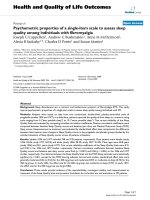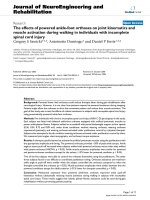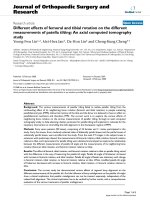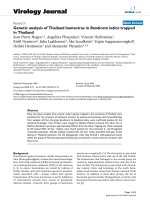Báo cáo hóa học: "Enzymatic Digestion of Single DNA Molecules Anchored on Nanogold-Modified Surfaces" pptx
Bạn đang xem bản rút gọn của tài liệu. Xem và tải ngay bản đầy đủ của tài liệu tại đây (380.21 KB, 6 trang )
NANO EXPRESS
Enzymatic Digestion of Single DNA Molecules Anchored
on Nanogold-Modified Surfaces
Junhong Lu
¨
Æ Ming Ye Æ Na Duan Æ Bin Li
Received: 9 January 2009 / Accepted: 14 May 2009 / Published online: 31 May 2009
Ó to the authors 2009
Abstract To study enzyme–DNA interactions at single
molecular level, both the attachment points and the
immediate surroundings of surfaces must be carefully
considered such that they do not compromise the structural
information and biological properties of the sample under
investigation. The present work demonstrates the feasibil-
ity of enzymatic digestion of single DNA molecules
attached to nanoparticle-modified surfaces. With Nanogold
linking DNA to the mica surface by electrostatic interac-
tions, advantageous conditions with fewer effects on the
length and topography of DNA are obtained, and an
appropriate environment for the activities of DNA is cre-
ated. We demonstrate that by using Dip-Pen Nanolithog-
raphy, individual DNA molecules attached to modified
mica surfaces can be efficiently digested by DNase I.
Keywords Gold nanoparticles Á Mica Á DNA Á
Atomic force microscopy Á Dip-Pen Nanolithography
Introduction
Advances in single-molecule techniques make it possible
to explore new phenomena and unravel novel mechanisms
in biology that were largely inaccessible by traditional bulk
measurements [1]. For example, studies of DNA–protein
interaction at single molecular level could characterize the
distributions of molecular properties and observe the tem-
poral evolution of complicated reaction pathways [2]. It is
generally understood that single-molecule measurements
require adsorption and fixation of single DNA molecules
on a solid support surface [1, 3] before the protein motion
along the DNA can be tracked. Among the many kinds of
substrate surfaces, mica is ideal because of its atomic
smoothness. Since newly cleaved mica is negatively
charged at basic pH [4], an advisable surface modification
is critical to bind the negatively charged phosphate back-
bone of DNA. Typically, poly-
L-lysine [5, 6], silane [7, 8],
and divalent cations, such as Ni
2?
and Mg
2?
, have been
used to provide positively charged sites and/or hydrophobic
surfaces for enhancing the interactions between DNA and
surfaces [4, 9, 10]. However, these modification methods
usually compromise the inherent surface roughness of
mica, making it more difficult to gain structural insight into
biomolecules with nanometer resolution. Also such modi-
fied surfaces are not well suited for dynamic measurements
of protein or DNA molecules, because the entire DNA
molecule is often fixed tightly on the surface, leading to
little or tardy response of the molecule to environmental
changes.
To fix DNA on a surface for investigation into its
interaction with other reactants, one strategy is to modify
the terminal of the DNA strands, so that they specifically
bind to surfaces [11–13]. For instance, van Oijen et al. used
biotin–avidin system to fix only one end and allow the rest
of the single DNA molecule to interact with exonuclease
[3]. Medalia et al. demonstrated a method that anchors two
ends of a DNA fragment with a thiol group on a gold film-
modified mica surface [14]. Recently, a novel strategy
named ‘‘protein-assisted DNA immobilization’’ was pro-
posed by Dukkipati et al. in which DNA binding proteins
such as restriction enzymes or RNA polymerases are used
Electronic supplementary material The online version of this
article (doi:10.1007/s11671-009-9350-6) contains supplementary
material, which is available to authorized users.
J. Lu
¨
Á M. Ye Á N. Duan Á B. Li (&)
Shanghai Institute of Applied Physics, Chinese Academy of
Sciences, P.O. Box 800-204, Shanghai 201800, China
e-mail:
123
Nanoscale Res Lett (2009) 4:1029–1034
DOI 10.1007/s11671-009-9350-6
as attachment points to adsorb DNA on surfaces [15].
Although this method can maintain the biological activity
of the immobilized DNA molecules, it is not suitable for
higher resolution imaging at nanometer scale by atomic
force microscopy (AFM), because hydrophobic polymeth-
ylmethacrylate (PMMA) surfaces have to absorb proteins.
We are working on single-molecule enzymatic reactions
on mica surfaces by controlled dipping of a nonspecific
endonuclease over the DNA molecules based on nanoma-
nipulation [16]. To simultaneously realize the goals of
obtaining structural insights into biomolecules with nano-
meter resolution and providing an appropriate condition for
their biological processes, we investigated enzymatic
reactions (DNase I) at single DNA molecules attached and
immobilized on mica surfaces functioned by gold nano-
particles (GNPs), 1.4 nm-diameter nanoparticles (Nano-
gold). We demonstrate that Nanogold-modified mica
surfaces (Nanogold-mica) have less effect on the length
and topography of DNA molecules and provide a suitable
environment for higher efficiency of enzymatic reactions
on DNA.
Materials and Methods
The original DNA solutions (Shanghai Sangon Biological
Engineering Technology and Services Co., Ltd) were
diluted to final concentrations of 1 ng/lL for k DNA and
0.1 ng/lL for pBR322, in TE buffer (10 mM TE–HCl, pH
8.0). Nanogold-mica was produced by treating freshly
cleaved mica with 1–50 fM Nanogold (Nanoprobes, Stony
Brook, NY) in water for 1 min. After being dried with
nitrogen gas, the ‘‘spin-stretching’’ technique was used to
stretch and fix DNA [17]. Briefly, 2–5 lL DNA was put on
a Nanogold-mica, which was adhered firmly on a centri-
fuge. The spin speed was limited to \3,000 rpm to extend
DNA for 30 s. Samples were washed twice with 10 lL
deionized water and dried for imaging.
AFM imaging was conducted using the tapping mode of
a MultiMode Scanning Probe microscope (NanoScope IIIa,
Digital Instruments, Santa Barbara, CA) with a J Scanner.
Noncontact cantilevers (NSC11, MikroMasch) with a res-
onance frequency of *300 kHz and a spring constant of
*40 Nm
-1
were used for imaging at room temperature (in
an ambient situation). All AFM images were flattened and
analyzed with the microscope’s software system. The
contour lengths of single DNA molecules and percentage
of DNA occupied on surfaces were determined using
METAMORPH software (MDS, Inc.) (see supporting
information on the method of calculating DNA length and
coverage).
For enzymatic digestion of DNA molecules, Dip-Pen
Nanolithography (DPN) [16, 18–20] was used to deposit
DNase I on DNA. Briefly, an AFM tip coated with 0.01–
0.05 unit/lL DNase I (Sigma) in 20 mM Tris–HCl, pH 8.3,
2 mM MgCl
2
, and 2 mM CaCl
2
was mounted on the
sample stage. After the first DNA image was obtained by
tapping mode, lift mode was turned on to move the AFM
tip closer to the surface by setting a negative lift height
value. The tip remained for a moment once it touched the
surface to induce a meniscus between the tip and the sur-
face. Then, the first image was scanned again with tapping
mode but this time by depositing DNase I on the surface
and the DNA. Afterwards, several images were recorded in
situ to observe the process of DNA digestion. The digestion
experiments were conducted in a relative humidity of 30–
40% and a temperature of 20–25 °C.
Results and Discussion
Nanogold is generally used as a contrast agent in electron
microscopy [21]. In our experiments, we utilize the unique
properties of the positively charged Nanogold to act as
cross-linker between negatively charged DNA and mica
through electrostatic interactions (Fig. 1a). We expect that
most parts of DNA are free except for the binding sites to
Nanogold. Due to the fact that only bare mica is used and
no other additional surface modification is needed, the
inherent surface properties of mica such as its atomic
flatness and hydrophilicity are less affected. So the features
of DNA can be clearly observed, and a suitable surface for
observing the biological activities of proteins can be
provided.
As shown in Fig. 1b and c, after the modification pro-
cess, the Nanogold, 1.4 nm in height, is randomly dis-
persed on the mica surface. The roughness of the mica
surface is changed a little by the sparse distribution of
small size nanoparticles. The root mean square (RMS)
roughness measured on the 1.75 lm 9 1.75 lm area of the
mica surface was *0.06 nm. Although there is a slight
increase in this value compared with a freshly cleaved mica
surface of *0.05 nm, it is sufficient for imaging DNA and
studying the interaction between protein and DNA.
We have successfully deposited and immobilized DNA
molecules in the presence of Nanogold. In principle, a
reasonable number of binding events are controlled by
varying the nanoparticles’ coverage on the surfaces. An
increase in Nanogold concentration increases the attach-
ment points on the surface, thus leading to more DNA
binding. Figure 2 shows the results of k DNA attachment
to a modified surface at two different Nanogold concen-
trations. In the case of 50 and 5 fM Nanogold, the coverage
of DNA fixed on Nanogold-mica is about 4% (Fig. 2a) and
1% (Fig. 2b) respectively. Depending on the application, a
different coverage of DNA attachment can be obtained.
1030 Nanoscale Res Lett (2009) 4:1029–1034
123
However, a higher density of Nanogold would influence
the topography of DNA, thus it is important to control the
numbers of Nanogold on mica surface to achieve a better
DNA topography. In Fig. 2b, there are a few nanoparticles
that are used to attach lambda DNA molecules on the
surface, and the lower DNA molecule is anchored only by a
single Nanogold. From the cross-section profile of Fig. 2c
as shown in Fig. 2d, the measured height of the binding site
is 1.8 nm (arrow 1), equaling the value of DNA height of
0.4 nm (the measured height of most parts of DNA, arrow
2), plus a Nanogold height of 1.4 nm (arrow 3). In addition,
there is the measured height of 0.8 nm (three thin arrows in
Fig. 2c) along DNA strands, implying other structures of
DNA existing on the surface.
We have also explored the general applicability of
Nanogold to deposit circular and linear DNA on mica.
Circular pBR322 DNA and Pst1 linearized pBR322 were
chosen for this purpose. It has been reported that the
enzyme sometimes shows limited catalytic activity on
overstretched DNA molecules. Although it is possible to
avoid overstretching by reducing the hydrophobic effects
during the DNA-stretching processes [22], the problem of
controlling this effect persists. However, in our experi-
ments, DNA molecules are easily attached but not over-
stretched. As shown in Fig. 3, the measured lengths of
DNA range from 1.31 to 1.48 lm regardless of linear or
circular molecules, which is very close to the actual length,
1.48 lm. The preserved conformation of DNA would be a
potential advantage for reactions of DNA with other mol-
ecules like proteins and enzymes.
After being able to reproducibly deposit linear and
circular DNA molecules on mica without overstretching
them, it would be very interesting to explore whether
DNA molecules attached on Nanogold-mica are beneficial
for the investigation into enzymatic reactions along a
single DNA molecule. To this end, a digestion reaction
with DNase I was carried out. DNase I is a paradigm
endonuclease used routinely for nonspecific cleavage of
DNA in molecular biology. Figure 4 shows the process of
the enzymatic reaction. The uniform linear DNA (Fig. 4a)
was digested into several fragments immediately (Fig. 4b)
after DNase I ink (bright spots in image) was transferred
from the coated tip to the surface and DNA. The size of
spots changed along with the time passed. About half an
hour later, the volume of the ink spots decreased greatly
(Fig. 4c). To observe DNA clearly, the sample was
imaged again after 10 h. All bright spots and most parts
of DNA disappeared, but tracks of DNA still remained
(Fig. 4d). This phenomenon is interesting, its mechanism
however is unclear so far. We think the disappearance of
ink (Fig. 4b–d) may be caused by the tip’s effects, such
as tip-induced diffusion and/or adsorption, during
Fig. 1 a Schematic showing of
the Nanogold-modified mica
and the anchored DNA on it
(not drawn to scale), b AFM
topography image of Nanogold
on a mica surface, and c The
corresponding cross-section
height profile of Nanogold
Nanoscale Res Lett (2009) 4:1029–1034 1031
123
scanning processes. Other factors, such as liquid evapo-
ration and liquid diffusion may also play a rule. To
exclude any chance that the observed gaps could have
been caused by mechanical force applied by the AFM
tip, control experiments with denatured enzyme were
performed, and no such digestion phenomenon occurred.
The results imply that the flat, hydrophilic Nanogold-mica
surface is suitable for the detection of enzymatic diges-
tions of DNA by AFM. We note that no additional sample
washing steps were needed; therefore, this technique not
Fig. 2 Typical AFM images of
lambda DNA anchored on
Nanogold-mica modified with a
50 fM and b 5 fM Nanogold.
Height bar = 5nmc An
enlarged image from the mini
square in Fig. 2b. Height
bar = 2nmd A height profile
of DNA indicated by a line in
Fig. 2c
Fig. 3 AFM images of DNA
anchored on Nanogold-mica
surfaces. a Stretched Pst1
linearized pBR322. b Circular
pBR322
1032 Nanoscale Res Lett (2009) 4:1029–1034
123
only completely eliminates any possible artifacts caused
by the water flow, but also has the potential to be
developed into a method for recording digestion reactions
in a time-lapse manner. It should be noted that although
the cleavage of DNA can be observed on other modified
surfaces, such as APTES-mica [16] and Ni-mica [23],
using Nanogold-mica facilitates the detection of small
gaps in the DNA due to the relatively free state of the
molecule. Most of the DNA has weak interaction with the
surface except at the points that are anchored by Nano-
gold. Once the phosphodiester linkages are broken, the
ends of the DNA fragments have a tendency to adjust
their positions because of their entropic property, so a
larger gap appears. Additionally, the modified surface is
flat, providing a unique platform to probe the topography
of DNA. Moreover, the entire smooth surface is hydro-
philic because of the hydrophilic mica surface and the
water soluble Nanogold. The flat, hydrophilic surface
facilitates ink and small DNA fragments to diffuse on the
substrate, leading to an enlarged gap and a clear view
field. So a digestion reaction of DNA can be probed
clearly, even without washing steps.
Conclusions
We have demonstrated that we are able to facilely deposit
and anchor DNA molecules on a mica surface using
Nanogold for single-molecule enzymatic reactions. The
immobilization of DNA on Nanogold-modified surfaces
does not require time-consuming steps, and the fixed DNA
strands on the surface can easily be observed on AFM
images. Because the Nanogold distribution largely deter-
mines the interaction forces between mica and the adsorbed
DNA molecules, we could minimize any possible influence
of the surface on the native properties of DNA molecules
by adjusting the concentrations of nanoparticles, thus
providing conditions in which distinct conformations of
DNA molecules and their interactions with proteins or
other materials can be studied better. By using Dip-Pen
Nanolithography to dip DNase I over DNA molecules, we
have realized to digest single DNA molecules with higher
efficiency. Further research toward more careful control
over the deposited density of the Nanogold on surfaces for
fixing DNA in solution and probe the structure-related
properties of DNA with various kinds of restriction
Fig. 4 AFM images of DNA
reaction of digestion by DNase
I. Height scales = 8 nm except
for (a). a DNA topography
before digestion. Height
scale = 2 nm. b DNA
fragments just after a DPN
process. c DNA fragments after
DPN 0.5 h. d Traces of DNA
after DPN 10 h
Nanoscale Res Lett (2009) 4:1029–1034 1033
123
endonucleases needs to be conducted. Some of this
research is currently under way in our research group.
Acknowledgment This work was supported by grants from NSFC
(10675160, 10604061, and 10874198).
References
1. M L. Visnapuu, D. Duzdevich, E.C. Greene, Mol. Biosyst. 4,
394 (2008). doi:10.1039/b800444g
2. E. Rhoades, E. Gussakoysky, G. Haran, Proc. Natl Acad. Sci.
USA 100, 3197–3202 (2003). doi:10.1073/pnas.2628068100
3. A.M. van Oijen, P.C. Blainey, D.J. Crampton, C.C. Richardson,
T. Ellenberger, X.S. Xie, Science 301, 1235 (2003). doi:10.1126/
science.1084387
4. H.G. Hansma, D.E. Laney, Biophys. J. 70, 1933 (1996). doi:
10.1016/S0006-3495(96)79757-6
5. M. Bussiek, K. Toth, N. Muecke, N. Brun, J. Langowski, Bio-
phys. J. 88, 58a (2005)
6. S.J.T. van Noort, O.H. Willemsen, K.O. van der Werf, B.G. de
Grooth, J. Greve, Langmuir 15, 7101 (1999). doi:10.1021/
la990459a
7. Y.L. Lyubchenko, A.A. Gall, L.S. Shlyakhtenko, R.E. Harring-
ton, B.L. Jacobs, P.I. Oden, S.M. Lindsay, J. Biomol. Struct. Dyn.
10, 589 (1992)
8. M. Sasou, S. Sugiyama, T. Yoshino, T. Ohtani, Langmuir 19,
9845 (2003). doi:10.1021/la035054b
9. T. Thundat, D.P. Allison, R.J. Warmack, G.M. Brown, K.B.
Jacobson, J.J. Schrick, T.L. Ferrell, Scanning Microsc. 6, 911
(1992)
10. T.F. Chan, C. Ha, A. Phong, D. Cai, E. Wan, L. Leung, P.Y.
Kwok, M. Xiao, Nucleic Acids Res. 34, e113 (2006). doi:
10.1093/nar/gkl593
11. S. Matsuura, J. Komatsu, K. Hirano, H. Yasuda, K. Takashima, S.
Katsura, A. Mizuno, Nucleic Acids Res. 29, e79 (2001). doi:
10.1093/nar/29.16.e79
12. J.H. Kim, R.G. Larson, Nucleic Acids Res. 35, 3848 (2007). doi:
10.1093/nar/gkm332
13. A. Crut, B. Geron-Landre, I. Bonnet, S. Bonneau, P. Desbiolles,
C. Escude, Nucleic Acids Res. 33, e98 (2005). doi:10.1093/nar/
gni097
14. O. Medalia, J. Englander, R. Guckenberger, J. Sperling, Ultra-
microscopy 90, 103 (2002). doi:10.1016/S0304-3991(01)00141-3
15. V.R. Dukkipati, J.H. Kim, S.W. Pang, R.G. Larson, Nano Lett. 6,
2499 (2006). doi:10.1021/nl0617484
16. B. Li, Y. Zhang, S.H. Yan, J.H. Lu, M. Ye, M.Q. Li, J. Hu, J. Am.
Chem. Soc. 129, 6668 (2007). doi:10.1021/ja0687015
17. H. Yokota, J. Sunwoo, M. Sarikaya, G. van den Engh, R.
Aebersold, Anal. Chem. 71, 4418 (1999). doi:10.1021/ac9902695
18. R.D. Piner, J. Zhu, F. Xu, S.H. Hong, C.A. Mirkin, Science 283,
661 (1999). doi:10.1126/science.283.5402.661
19. B. Li, Y. Zhang, J. Hu, M.Q. Li, Ultramicroscopy 105, 312
(2005). doi:10.1016/j.ultramic.2005.06.056
20. J. Hyun, J. Kim, S.L. Craig, A. Chilkoti, J. Am. Chem. Soc. 126,
4770–4771 (2004). doi:10.1021/ja049956q
21. J.F. Hainfeld, R.D. Powell, J. Histochem. Cytochem. 48
, 471
(2000)
22. Z. Gueroui, C. Place, E. Freyssingeas, B. Berge, Proc. Natl Acad.
Sci. USA 99, 6005 (2002). doi:10.1073/pnas.092561399
23. O. Pietrement, D. Pastre, F. Landousy, M.O. David, S. Fusil, L.
Hamon, A. Zozime, E. Le Cam, Eur. Biophys. J. 34, 200 (2005).
doi:10.1007/s00249-004-0443-y
1034 Nanoscale Res Lett (2009) 4:1029–1034
123









